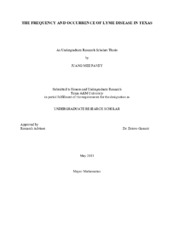| dc.creator | Pavey, Juang Mee | |
| dc.date.accessioned | 2015-09-03T15:25:13Z | |
| dc.date.available | 2015-09-03T15:25:13Z | |
| dc.date.created | 2013-05 | |
| dc.date.issued | 2013-02-06 | |
| dc.date.submitted | May 2013 | |
| dc.identifier.uri | https://hdl.handle.net/1969.1/154900 | |
| dc.description.abstract | This study examines the frequency and spatial occurrence of Lyme Disease (LD) within the state of Texas. According to the CDC, LD is the most prevalent arthropod borne disease in the US with 33,097 cases reported last year 2011. In 2009 the case definition of LD was revised and it differentiates in between confirmed and probable cases for this disease. Taking this into account, Texas is the only state in the US in which the ratio of probable versus confirmed cases is
repetitively as high as 2:1. This ratio can be attributed to many different causes, from doctors’ disregard for the disease and not testing for it, to the presence of genetically distinct Borrelia species and/or Ixodes scapularis tick vectors in Southern US. Thus it is important to develop a
firm understanding of the distribution of tick vectors in Texas. An important tool hampering the study of LD has been the lack of a valid and reliable LD diagnosis protocol for veterinary
purposes. Dr. Esteve-Gassent’s laboratory here at Texas A&M has generated data regarding canine LD and ticks containing B. burgdorferi sensu stricto. The data for the canine LD comprised of western blots, ELISA tests and IFA diagnostics on a collection of over 800 animals. Ticks were collected during the same timeframe (Fall 2011 through Sumer 2012) and analyzed with PCR for various genetic markers to determine the presence of B. burgdorferi. This work has already determined cutoff values for the ELISA test that determine which animal samples are true positives and which are true negatives. This work has shown that the standard IFA testing is not a reliable methodology for diagnostics in Veterinary Medicine. We aim to
generate a series of maps displaying the distribution of canine LD cases, positive ticks and human cases, and determine the level of correlation of these distributions. The goal of this
project is to determine whether or not canine LD can be used as an indicator of areas of high risk for human LD. | en |
| dc.format.mimetype | application/pdf | |
| dc.subject | Lyme Disease, Borrelia burgdorferi, sentinels | en |
| dc.title | The Frequency and Occurrence of Lyme Disease in Texas | en |
| dc.type | Thesis | en |
| thesis.degree.department | Mathematics | en |
| thesis.degree.discipline | Mathematics | en |
| thesis.degree.grantor | Honors and Undergraduate Research | en |
| dc.contributor.committeeMember | Esteve-Gassent, Dr. Maria | |
| dc.type.material | text | en |
| dc.date.updated | 2015-09-03T15:25:13Z | |


